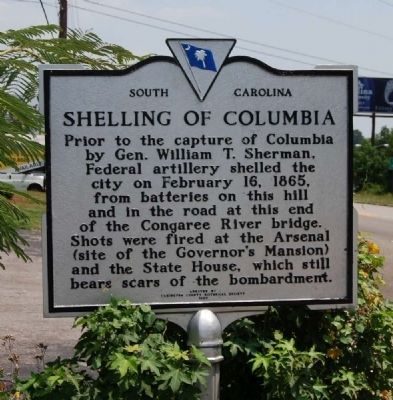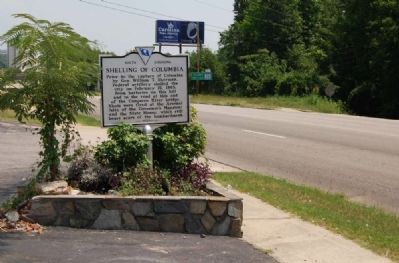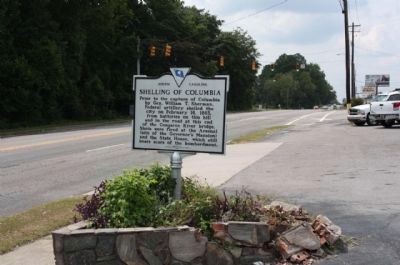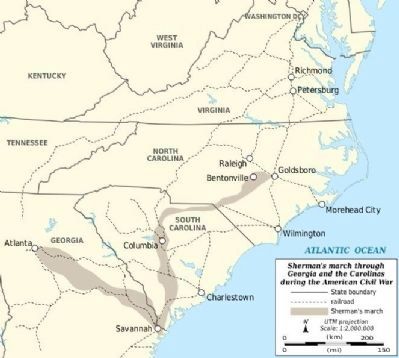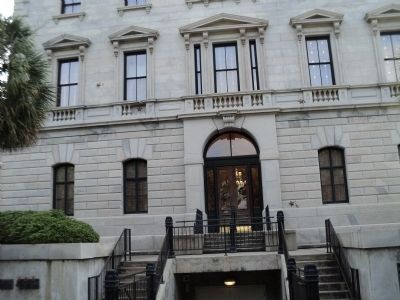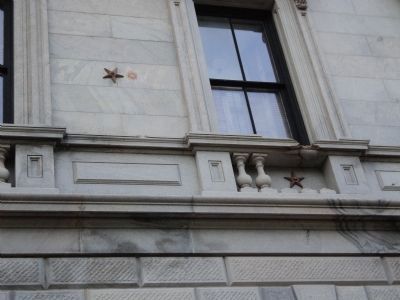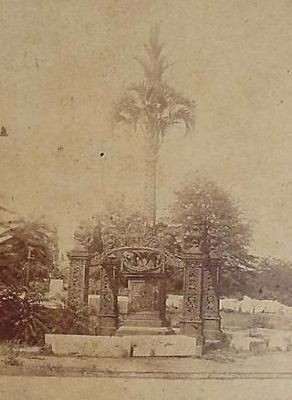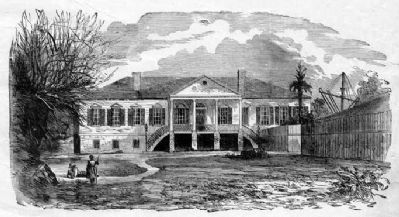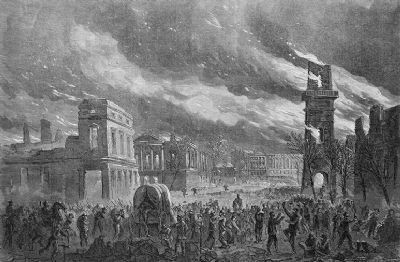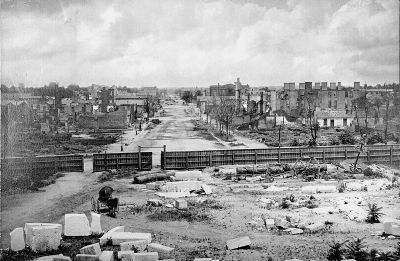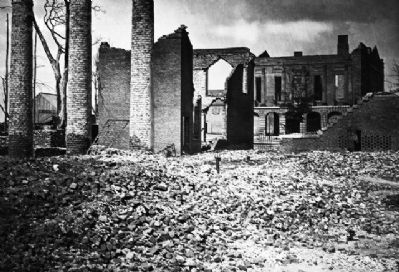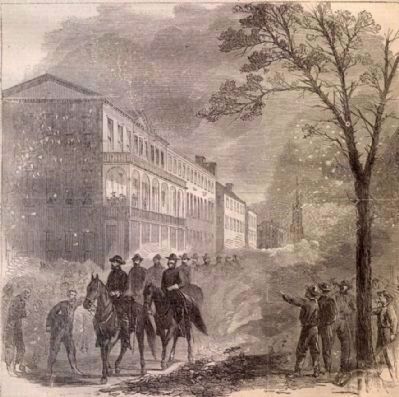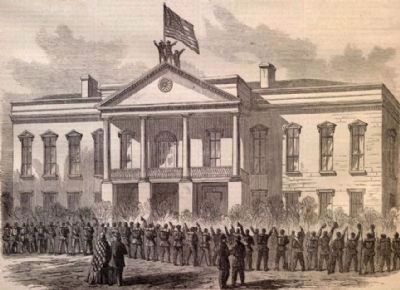West Columbia in Lexington County, South Carolina — The American South (South Atlantic)
Shelling of Columbia
Erected 1964 by Lexington County Historical Society. (Marker Number 32-5.)
Topics. This historical marker is listed in this topic list: War, US Civil. A significant historical date for this entry is February 16, 1865.
Location. 33° 59.8′ N, 81° 3.789′ W. Marker is in West Columbia, South Carolina, in Lexington County. Marker is at the intersection of Sunset Boulevard (U.S. 378) and North Lucan Street, on the left when traveling east on Sunset Boulevard. Touch for map. Marker is in this post office area: West Columbia SC 29169, United States of America. Touch for directions.
Other nearby markers. At least 10 other markers are within walking distance of this marker. Old Congaree River Bridges (approx. 0.6 miles away); River Inn, c. 1740s (approx. 0.6 miles away); Gervais Street Bridge (approx. 0.6 miles away); Friday’s Ferry (approx. 0.6 miles away); “City of Columbia” Anchor (approx. 0.6 miles away); Milestones (approx. 0.7 miles away); Congaree River Bridges (approx. 0.8 miles away); 1896 Power Plant (approx. 0.8 miles away); a different marker also named Gervais Street Bridge (approx. 0.8 miles away); Harnessing Water Power (approx. 0.8 miles away). Touch for a list and map of all markers in West Columbia.
Also see . . .
1. William Tecumseh Sherman. William Tecumseh Sherman (February 8, 1820 – February 14, 1891) was an American soldier, businessman, educator and author. (Submitted on August 15, 2009, by Brian Scott of Anderson, South Carolina.)
2. Columbia, South Carolina, in the American Civil War. The Southern United States city of Columbia, South Carolina, was an important political and supply center for the Confederate States Army during the American Civil War. (Submitted on August 15, 2009, by Brian Scott of Anderson, South Carolina.)
3. Battle Of Columbia Reenactment - May 6, 2006 (youtube.com). Eight minute edited version of the four-hour event. (Submitted on August 15, 2009, by Brian Scott of Anderson, South Carolina.)
Additional commentary.
1. Columbia Burns
On February 15, 1865, the sixty-three thousand men of Union Major General William T. Sherman's army were within three miles of what many of them considered their ultimate goal, the capital of South Carolina.
Many of the Federal soldiers, and maybe some of their generals, had decided to make an example of Columbia. The destruction of a handful of small towns and scores of plantations and farms had not attracted enough attention or given enough satisfaction. Perhaps something a little bigger would be necessary. A town with a prewar population of eight thousand, and a refugee-swollen population of twenty thousand, could fit the bill.
The shelling of Columbia started on February 16, 1865, much to the surprise of the city's mayor, who had not been contacted by Federals demanding the city's surrender. The unauthorized shelling even surprised Sherman, who rode up to Lexington Heights on the west bank of the Saluda River to find out what was happening. The captain in command of the artillery said he had seen Confederate cavalry moving in the streets. That was unlikely since the Confederate cavalry had retreated some time earlier. Sherman ordered the captain to tighten his aim and shoot only at the unfinished capitol building about three miles away.
Sherman expected little actual fighting in the city and selected Union Major General John Logan's 15th Corps as an occupation force. On the afternoon of February 17, 1865, a pontoon bridge over the Saluda
River was completed. Just before crossing, Sherman received his first civilian message asking for mercy for the city. The message was from Sister Baptista, the mother superior of a Catholic convent in the city. Sister Baptista informed Sherman that she had taught his daughter at a convent school in Ohio. Sherman wrote a note back assuring her that no private property, least of all a Catholic school, would be harmed by his men.
The 15th Corps must not have gotten the word. As they marched across the river, no more than fifty yards behind Sherman, most of them were chanting: "Hail Columbia, happy land. If I don't bum you, I'll be damned!" Sherman must not have heard the voices of fifteen thousand men threatening the city. He never looked behind him.
Many of the citizens were glad to see the Federals, at least they made it appear so. They sang "Yankee Doodle" and waved United States flags. Some citizens did a stupid thing. They gave the troops liquor-lots of it.
Other citizens were not at all pleased with the arrival of the Yankees.
Emma LeConte watched as the United States flag was raised over the capitol building near where she was living at South Carolina College (now University of South Carolina). "Oh, what a horrid sight. What a degradation! After four long bitter years of bloodshed and hatred, now to float there at last! That hateful symbol of despotism!" she wrote in her diary. When she got her first look at real live Yankee soldiers she wrote, "We cannot look on them with anything but horror and hatred-loathing and disgust!"
Miss LeConte was not selected to serve on the mayor's welcoming committee.
The troops soon made themselves very unwelcome. As soon as they stacked arms, the men scattered, going house-to-house in search of food and valuables.
While his men were ransacking homes, Sherman went visiting. He remembered that an old female acquaintance lived in Columbia. When he arrived at her home, he was surprised that it was untouched, when all of the houses around it had been ransacked by his troops. He asked the woman how she had managed to keep his men at bay. She showed Sherman a book of watercolors he had given her long ago. He had given it as a gift and signed it, "W.T. Sherman, First Lieutenant, Third Artillery." Impressed that the woman had kept the book and was smart enough to show it to any prowling Federals, Sherman ordered a guard put on the house for the rest of his stay in Columbia. With her, at least, he kept his word.
At the end of the day, Sherman told the exhausted mayor, who had been following the general around like a puppy, "You may lie down to sleep, satisfied that your town shall be as safe in my hands as if wholly in your own."
Again, Sherman
did not keep his word. Before he could climb into bed that night, the general noticed the shadows of flames dancing on the bedroom wall. His men had been in the city less than eight hours.
While the Federals claimed the Columbia fire probably was started by smoldering cotton fires started by retreating Confederates, evidence suggests at least twenty fires were started in different parts of the city by Federal soldiers. Other fires sprang up from sparks carried by an unusually strong wind that night.
Even as the city burned, soldiers plundered, sometimes waiting to see what valuables women would bring with them while evacuating their burning houses.
Sister Baptista, the nun who was promised protection by Sherman, finally led thirty little girls out of the convent's school just as the building burst into flames. They first went into St. Peter's Catholic Church. They fled the church when it was set on fire by soldiers. Those flames were extinguished, but Sister Baptista thought staying inside the church was too risky. She took the girls into the cemetery, where they huddled among the tombstones for the night.
Several buildings on the South Carolina College campus caught on fire, including a hospital. The hospital's wounded were forced to hobble out into the cold. Those who could not walk perished.
Stories about the night Columbia burned are filled with tales of heroism, terror, and even some humor. A lady and her maid were yelling at marauding soldiers when one soldier stopped to help. He chased the other soldiers out from each room of the lady's house. He told the lady he would stay with her and keep out all invaders if she would give him just one thing from the house.
"Please take anything you wish. We owe everything to you," the relieved woman said.
The soldier ran upstairs and reappeared a few minutes later wearing a purple velvet cloak, a doublet, and white satin hose, the costume the woman's husband had once worn to a ball. The last the women saw of the soldier was when he left at dawn, waving goodbye with a flourish of his purple cloak. One wonders if any Confederates at the Battle of Bentonville the following month noticed they were shooting at Sir Walter Raleigh.
The day after the fire, Sherman wrote that the sun rose "bright and clear over a ruined city." He estimated that half of the city's buildings had burned. An actual count by city officials tallied 460 burned buildings and houses, about one-third of the city's structures. The fire ran from the Old State House up Main Street (called Richardson Street at the time) to Elmwood Street. The worst destruction was on either side of Main Street, from Senate to Laurel Streets. A Federal major wrote in his diary that "Columbia will have bitter cause to remember the visit of Sherman's army." He predicted it would be a century before the city would recover.
Sherman went to the Catholic church, where he found the little girls huddled around Sister Baptista. The general took the nun's hand and said, "Oh, there are times when one must practice patience and Christian endurance."
According to one of the girls, who later wrote about the incident, the mother superior, her robe burned and scorched from the flames, stared at the general from beneath her hood. "You have prepared for us one of those moments, General," she said evenly, without malice in her voice. "This is how you kept your promise to me, a cloistered nun?"
Sherman, who commanded the second largest army on the American continent and had fought and beaten thousands of Indians and Confederates, was left stammering by a single woman of God.
Sherman offered to let Sister Baptista have any of the remaining unburned houses in the city for her girls. After admonishing Sherman that he had no right to give her any houses since he did not own any in Columbia, she selected the John S. Preston house. Preston, who had run South Carolina's conscription service, abandoned the city during Sherman's approach. His house was now occupied by Union Major General John Logan, commander of the 15th Corps.
Logan looked up
from his breakfast that morning to see a line of little girls dressed in dirty white dresses being led up the walk by a nun. He was enraged that a nun and some little girls could put him out of his headquarters, particularly since he had already prepared the mansion for burning by rolling barrels of pine pitch into the basement. He cursed Sister Baptista and the little girls and ordered them out of his house. From under her habit, the nun pulled out Sherman's order giving her possession of the house. Logan cursed again, but ordered the barrels removed. Once again, a single nun had defeated a powerful Union general.
This time, Sherman kept his word to Sister Baptista. She and the girls were bothered no more. However, they were saddened at how the Federal officers treated John Preston's beautiful house. Fine paintings were slashed, mustaches were drawn on portraits, and statues were smashed.
Sherman always publicly denied responsibility for the fire in Columbia, even though his men had burned every other town they marched through with his approval. He wrote, "Though I never ordered it and never wished it, I have never shed many tears over the event, because I believe it hastened what we all had fought for, the end of the War."
There was one last incident during the city's occupation, an act of stupidity that must have made many Columbians chuckle. Sherman
ordered all of the abandoned Confederate ammunition in the arsenal thrown in the river; he was afraid that blowing it up might injure his men. As the powder and shells were loaded onto wagons for the short ride to the water, one clumsy soldier dropped a box of black powder. Whether he was smoking or not will never be known, but somehow, a flame ignited the powder trail the soldier had unwittingly left behind him as he walked between the wagons and the arsenal. The flame burned up the powder trail right to the wagons. The resulting explosion killed more than twenty Union soldiers and wounded a large number, more than had been lost in the almost bloodless assault on Columbia.
Three days after they had arrived, Sherman's army moved out. When they had first entered the city, crowds of people had lined the streets to cheer them. When they left, the same crowds lined the blackened, smoldering streets to jeer them. (Source: Touring the Carolina's Civil War Sites by Clint Johnson (1996), pgs. 297-302.)
— Submitted August 15, 2009, by Brian Scott of Anderson, South Carolina.
Credits. This page was last revised on December 14, 2019. It was originally submitted on August 15, 2009, by Brian Scott of Anderson, South Carolina. This page has been viewed 3,245 times since then and 138 times this year. Photos: 1, 2. submitted on August 15, 2009, by Brian Scott of Anderson, South Carolina. 3. submitted on August 30, 2010, by Mike Stroud of Bluffton, South Carolina. 4. submitted on August 15, 2009, by Brian Scott of Anderson, South Carolina. 5, 6. submitted on August 24, 2013, by Bill Coughlin of Woodland Park, New Jersey. 7, 8, 9, 10, 11, 12, 13, 14. submitted on August 15, 2009, by Brian Scott of Anderson, South Carolina.
